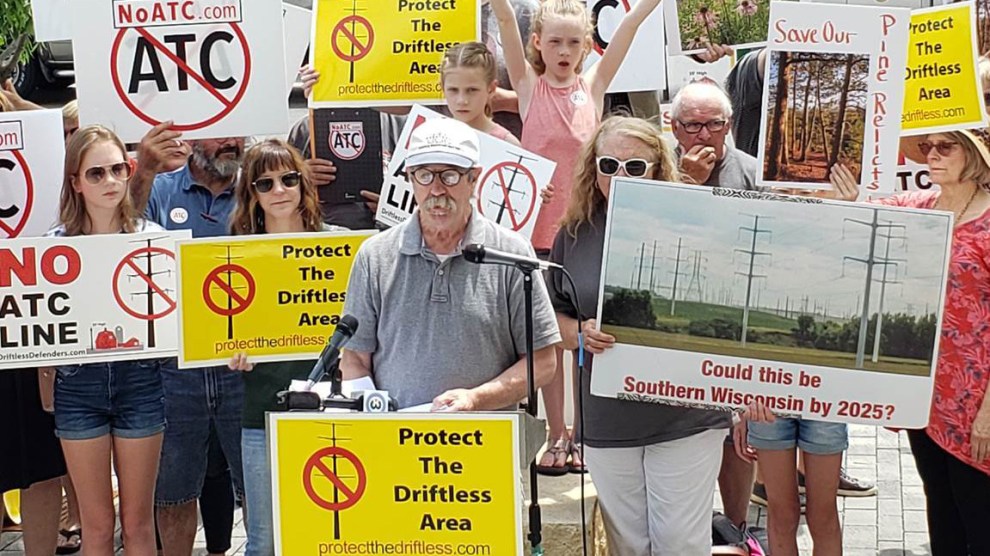
Illustration by: Nick Dewar
It’s eight o’clock on a fresh summer morning in Denver, and I’m at a podium before a hundred executives from regional energy companies. Having spent the last few years closely observing trends in the oil industry, I’m often asked to speak about the decline of global energy supplies, the way oil has corrupted U.S. foreign policy, and why the worldwide energy economy needs a radical transformation if we want to avoid catastrophic climate change. Yet while these themes play well to liberal audiences in Boulder and Berkeley, I worry my reception here will be much cooler. Most of these weather-beaten men (and a few women) spend their days squeezing hydrocarbons from the sand and stone beneath the Rockies; if my past observations of the energy industry are any guide, they voted for Bush, support the Iraq war, think climate change is a leftist hoax, and believe the main cause of America’s energy crisis is that overzealous regulation keeps drillers like themselves from tapping the most promising reserves of oil and natural gas.
But as I finish my spiel and take questions, my initial assumptions vanish. When I suggest that the Iraq war might not have been motivated entirely by America’s thirst for oil, many in the room openly smirk, as if I’ve just suggested that the world is flat. Likewise, few here seem to share the White House’s Panglossian view that the United States is sitting atop some massive, but politically off-limits, reserve of natural gas. In fact, as much as these executives would love to sink their drills anywhere they want — and as much as they detest environmentalists for stopping them — no one here believes the volume of natural gas yet to be discovered in the Rockies, or anywhere else in America, would reverse the nation’s decline of gas production or let the United States move to a cleaner, more secure “gas” economy. As one executive tells me, “even if all the off-limits land were opened for drilling, all the new gas we could bring on-line wouldn’t be enough to replace all the production we’re losing from older fields. We’d barely keep production flat.”
For those who wonder where the world will be getting its energy a decade from now, confessions like these only confirm what many have feared for some time: namely, that the cheap, “easy” oil and natural gas that powered industrial growth for a century no longer exist in such easy abundance; and that we may have a lot less time than we thought to replace that system with something cleaner, more sustainable, and far less vulnerable to political upheaval.
The evidence is certainly piling up. Pollution levels from cars and power plants are on the rise. Climate change, another energy-related disaster, has begun impacting crop yields and water supplies and may soon provoke political strife. In fact, according to a Pentagon report last October, global warming could make key resources so scarce, and nations so desperate, that “disruption and conflict will be endemic” and “warfare would define human life.”
Yet the most alarming symptoms of an energy system on the verge of collapse are found in the oil markets. Today, even as global demand for oil, led by the economic boom in Asia, is rising far faster than anticipated, our ability to pump more oil is falling. Despite assurances from oil’s two biggest players — the House of Bush and the House of Saud — that supplies are plentiful (and, as George W. Bush famously put it, that getting the oil is just a matter of “jawboning” “our friends in OPEC to open the spigots”), it’s now clear that even the Saudis lack the physical capacity to bring enough oil to desperate consumers. As a result, oil markets are now so tight that even a minor disturbance — accelerated fighting in Iraq, another bomb in Riyadh, more unrest in Venezuela or Nigeria — could send prices soaring and crash the global economy into a recession. “The world really has run out of production capacity,” a veteran oil analyst warned me in late August. “Iraq is producing less than a third of the oil that had been forecast, the Saudis are maxed out, and there is no place else to go. And America is still relying on an energy policy that hasn’t changed significantly in 20 years.”
Nor is it any longer a matter of simply drilling new wells or laying new pipe. Oil is finite, and eventually, global production must peak, much as happened to domestic supplies in the early 1970s. When it does, oil prices will leap, perhaps as high as $100 per barrel — a disaster if we don’t have a cost-effective alternative fuel or technology in place. When the peak is coming is impossible to predict with precision. Estimates range from the ultra-optimistic, which foresee a peak no sooner than 2035, to the pessimistic, which hold that the peak may have already occurred. In any case, the signs are clear that the easy oil is harder to find and what remains is increasingly difficult and expensive to extract. Already, Western oil companies are struggling to discover new supplies fast enough to replace the oil they are selling. (Royal/Dutch Shell was so concerned about how declining discovery rates would devastate its stock price that it inflated its reserves figures by 20 percent.)
Worse, according to a new study in the respected Petroleum Review, in the United Kingdom, Indonesia, Gabon, and 15 other oil-rich nations that now supply 30 percent of the world’s daily crude, oil production — that is, the number of barrels that are pumped each day — is declining by 5 percent a year. That’s double the rate of decline of even a year ago, and it has forced other oil producers to pump extra simply to keep global supplies steady. “Those producers still with expansion potential are having to work harder and harder just to make up for the accelerating losses of the large number that have clearly peaked and are now in continuous decline,” writes Chris Skrebowski, editor of Petroleum Review and a former analyst with BP and the Saudi national oil company. “Though largely unrecognized, [depletion] may be contributing to the rise in oil prices.”
If there is one positive sign, it’s that the high prices seem to have finally broken through America’s wall of energy denial. In fact, while energy experts like Skrebowski have been fretting about oil dependency and depleting reserves since the 1970s, today’s energy anxiety is no longer coming simply from academia or the political margins. In recent months, energy problems have come under intense focus by the mainstream media, filling radio and TV talk shows and newsmagazines. Whereas official U.S. policy still blames OPEC for our oil woes, even right-of-center, pro-business outlets like Business Week, The Economist, and Fortune have acceded that the biggest risk for U.S. energy security isn’t “foreign” producers or even environmentalists, but rather a decades-old domestic energy policy that remains focused almost entirely on finding new supplies while doing nothing to curb demand. “Much as we might like to, we can’t blame it on OPEC,” noted Fortune in August. “After all, Americans have been on a two-decade oil pig-out, gorging like oversized vacationers at a Vegas buffet.”
What’s more, while a powerful, ideologically driven minority — led, sadly, by the Bush administration — continues to insist that energy security is simply a question of drilling in the Arctic National Wildlife Refuge (ANWR) or browbeating OPEC, outside the White House, and certainly outside the Beltway, there’s a growing push to build a fundamentally new energy system. Thus, while the Bush administration dithered on climate change and the future of energy, individual states, like California and New York, enacted their own alternative energy policies and even sued utilities over carbon dioxide emissions. The corporate world, once a stalwart opponent of any policy reform, has become startlingly progressive. Toyota and Honda are busily rolling out hybrid cars. Agriculture and insurance firms warn of the future costs of oil-price swings and climate change. And energy companies like BP and Shell, eager to profit in the new energy order, are developing new fuels and technologies to help reduce oil use and emissions.
And if most U.S. consumers still share the administration’s energy obliviousness (U.S. gasoline consumption continues to rise, despite high oil prices), some in Congress have become downright activist. Last year in the Senate, Republican John McCain and Democrat Joseph Lieberman came close to passing a climate policy far beyond anything the White House has countenanced. In fact, even some traditional oil-and-gas politicians appear to see the writing on the wall. For example, U.S. Senator Lisa Murkowski, a Republican from Alaska and still an ardent supporter of drilling for oil in ANWR, nonetheless concedes “this nation needs to do a far better job of energy conservation and needs to develop alternative energy technologies to wean us from fossil fuels.”
Unfortunately, as encouraging as all this new energy awareness is, actually weaning the United States from fossil fuels is far easier said than done. To begin with, our current energy infrastructure — the pipelines and refineries, the power plants and grids, the gasoline stations, and, of course, the cars, trucks, planes, and ships — is a massive, sprawling asset that took more than a century to build and is worth some $1 trillion. Replacing that hydrocarbon monster with “clean” technologies and fuels before our current energy problems escalate into catastrophes will likely be the most complex and expensive challenge this country has ever faced.
And just as we’ve tended to underplay the flaws in our hydrocarbon energy system, we’ve also held far too rosy a notion of the various energy alternatives that are supposed to replace oil. In fact, to the extent that most politicians even discuss alternative energy, it tends to be in the rhetoric of American Can-Doism, a triumphant vision in which the same blend of technological prowess, entrepreneurial spirit, and market forces that helped us build an atom bomb, put a man on the moon, and produce the TV dinner and the microchip can now be counted on to yield a similar miracle in energy. Thus we find ourselves imagining a future powered by solar cells, bio-diesel, wind farms, tidal power, cold fusion, and, of course, hydrogen fuel cells, all currently being created in busy research labs and brought to us by a Free Market that is responding naturally, efficiently, and inexorably to the rising price of oil.
Yet the hard truth is that this hyper-optimistic dream is plagued by a variety of potentially killer flaws. First, many of these new technologies are nowhere near ready for prime time, and exist mainly in the conceptual stage, if that. Second, of the alternative fuels and gadgets that are technically viable today, many simply cannot compete with fossil fuels or existing technologies. Third, while the market is indeed a marvelous mechanism for bringing innovation to life, the modern economy doesn’t even recognize that the current energy system needs replacing. You and I may know that hydrocarbons cost us dearly, in terms of smog, climate change, corruption, and instability, not to mention the billions spent defending the Middle East. But because these “external” costs aren’t included in the price of a gallon of gasoline, the market sees no reason to find something other than oil, gas, or coal.
In late July 2004, financial analysts from across North America joined a conference call with Dennis Campbell, the embattled president of a shrinking Canadian company called Ballard Power Systems. Just a few years before, Ballard had been the toast of energy investors and the acknowledged leader in the campaign to move beyond oil. Its main product, a compact hydrogen fuel cell that could power a car, was widely hailed as the breakthrough that would smash the century-long reign of the gasoline-powered internal combustion engine. In early 2000, Ballard shares were trading for $120, allowing the company to raise a near-record $340.7 million in financing and touching off a wave of expectations that a fuel-cell revolution was imminent.
Since then, however, as fuel cells have been hobbled by technical problems, Ballard has seen its share value plummet to $8, as energy investors have all but abandoned hydrogen in favor of the latest energy darling, the gas-electric hybrid. During the conference call, Campbell insisted that hybrids were only a temporary fix, and that fuel cells remained the only long-term solution to problems like climate change and declining energy supplies. He was, however, forced to acknowledge that consumers and businesses alike were “discouraged by the long wait and the uncertain timelines” for fuel cells and had been “seduced by the lure of an easier solution to the energy and environmental challenges that we face.”
In many respects, Ballard is the perfect cautionary tale for the entire roster of alternative fuels and energy technologies, which, for all their huge promise, are, upon closer inspection, plagued by problems. For example, many energy experts see natural gas as the most logical interim step in eventually weaning ourselves from oil. Natural gas emits less carbon dioxide and pollutants than does oil (and certainly coal); it can be used in everything from cars to power plants; it’s also easily refined into hydrogen — all of which make it the perfect “bridge” fuel between the current oil-based economy and something new. But even as demand for gas grows in the United States, domestic production is in decline, meaning we’ll have to import an increasing volume via pipelines from Canada or through liquefied natural gas terminals in port cities. Even assuming we overcome the political hurdles, simply building this costly new infrastructure will take years, and, once completed, will leave us dependent on many of the same countries that now control the oil business. (The biggest gas reserves are in the Middle East and Russia.)
Above all, gas doesn’t solve the climate problem; it merely slows the rate at which we emit carbon dioxide. According to the United Nations Intergovernmental Panel on Climate Change, in order to cut CO2 emissions fast enough to actually prevent catastrophic warming, we eventually need to produce most of our energy with carbon-free technology. And we’re a long way from “most.” Today, hydrocarbons own the energy market — 40 percent of our energy comes from oil, 23 percent each from gas and coal. Nuclear provides around 8 percent, while renewable, carbon-free energy accounts for barely 5 percent of our total energy supply. Of that “good” energy, nearly 90 percent comes from hydroelectric dams, which are so expensive and environmentally nasty that their future role is extremely limited. The rest comes mainly from “biomass” usually plants and crop waste that are either refined into fuels, like ethanol, or burned to make steam.
And what about solar and wind? As it turns out, the two most famous alternative energy technologies together generate less than half a percent of the planet’s energy. Here’s a depressing fact: The entire output of every solar photovoltaic (PV) cell currently installed worldwide — about 2,000 megawatts total — is less than the output of just two conventional, coal-fired power plants.
Why do alternatives own such a puny share of the market? According to conventional wisdom, Big Oil and Big Coal use their massive economic power to corrupt Big Government, which then hands out massive subsidies and tax breaks for oil and coal, giving hydrocarbons an unbeatable advantage over alternatives. In truth, much of the fault lies with the new energy technologies themselves, which simply cannot yet compete effectively with fossil fuels.
Consider the saga of the solar cell. Despite decades of research and development, solar power still costs more than electricity generated from a gas- or coal-fired power plant. And although PV cell costs will continue to fall, there remains the problem of “intermittency” — solar only works when the sun is shining, whereas a conventional power plant can crank out power 24 hours a day, 365 days a year. (Wind presents a similar problem.) To use solar and wind, utilities must have backup power, probably coal- or gas-fired plants.
Eventually, utilities will solve the intermittency problem — probably with superfast “smart” power grids that can connect wind or solar farms built across the nation, or even the hemisphere, effectively getting power from wherever the sun is shining or the wind is blowing and delivering it to customers. But the very scale of this solution illustrates an even more serious weakness for wind and other renewables: They lack the “power density” of the fossil fuels they seek to replace. Coal, for example, packs a great deal of stored energy in a relatively small volume. As a result, a coal-fired plant requires only a few hundred acres of space, yet can supply electricity for 200,000 homes. By contrast, to generate equal power from wind, which is far less power-dense, you’d need a wind farm of more than 200 square miles in size. Given that by 2030, almost 60 percent of the global population is expected to live in cities of 1 million or more, meeting our power needs with wind, solar, or other renewables will be challenging indeed. “Supplying those buildings from locally generated renewable energies is either impractical or impossible,” says Vaclav Smil, an expert in energy economics at the University of Manitoba. The “power-density mismatch is simply too large.”
The most dramatic example of the mismatch between fossil fuels and their would-be competitors, however, can be found in the fuel cell. For decades, hydrogen proponents have argued that fuel cells, which turn hydrogen and oxygen into electricity while emitting only water vapor, are the key to the next energy economy. Like a battery that never needs charging, fuel cells can power office buildings, laptops, and especially cars, where they are roughly three times as efficient as a traditional internal combustion engine. And because you can make hydrogen by running electric current through water, advocates envisioned a global system in which power from solar, wind, and other renewables would be turned into hydrogen.
This compelling vision helps explain why the “hydrogen economy”was so touted during the 1990s, and why companies like Ballard Power Systems could partner with giants like DaimlerChrysler and Ford, igniting a fuel-cell mania that dazzled investors and policymakers alike. Indeed, in his 2003 State of the Union address, President Bush vowed that, within 20 years, fuel cells would “make our air significantly cleaner, and our country much less dependent on foreign sources of oil.”
In truth, even as the president was promising better living through hydrogen, the reality of a hydrogen economy was moving farther and farther away. While the basic technology remains prom-ising, making hydrogen turns out to be far more difficult than advertised. The easiest and by far cheapest method — splitting natural gas into carbon and hydrogen — is hampered by domestic shortages of natural gas. And while it is possible to extract hydrogen from water using renewably generated electricity, that concept suffers from the power-density problem. Studies by Jim MacKenzie, a veteran energy analyst with the World Resources Institute, show that a solar-powered hydrogen economy in the United States would require at least 160,000 square miles of photovoltaic panels — an area slightly larger than the state of California — and would increase national water consumption by 10 percent. “We could do it,” MacKenzie told me last year. “But it would be expensive.”
But hydrogen’s biggest problem is the fuel cell itself, which, despite decades of research, is still too expensive and unreliable to compete with the internal combustion engine. As of last year, the best fuel cells were still 10 times as costly as an equivalently powered gasoline engine. Hydrogen advocates argue that once fuel cells can be mass-produced, costs will drop dramatically. Yet while that’s true, it’s also true that gasoline engines will also improve over time — in fact, they already have. With the gasoline-electric hybrid, for example, the internal combustion engine has, in a stroke, doubled its fuel economy and halved its emissions — but without forcing consumers to use a complicated new technology or fuel. Barring some technological breakthrough that dramatically lowers costs or improves performance, the fuel cell may remain one step behind the gasoline engine for a long time, further delaying the moment it can begin displacing its hydrocarbon rival.
This, then, is the central dilemma facing the architects of the next energy economy. Left to themselves, markets will indeed move us to new energy technologies, but these technologies may not be the ones we ultimately want or need. For example, while the hybrid does cut emissions and fuel use, as Ballard’s Campbell testily points out, hybrids “still require fossil fuel” and thus can only be an interim solution. To be sure, interim solutions are essential, but if we concentrate only on half-measures, long-term technologies may not become economically viable fast enough to stave off an implosion of our energy system — be it from runaway climate change in 2015 or the collapse of the Saudi government in 2005.
Thus a true energy revolution — one that begins moving away from fossil fuels entirely — can’t succeed or even get started until we can somehow induce the market to “see” the true costs of energy, and, specifically, just how environmentally and politically expensive “cheap” fossil fuels really are.
One approach would be to copy the European Union’s “cap-and-trade” system, which sets a cap on how much CO2 companies can emit, but allows firms that cut emissions faster to sell their carbon “credits” to companies that can’t. As carbon becomes a cost to avoid, companies have a huge incentive to cut CO2 emissions — first by burning hydrocarbons more efficiently, but eventually by developing technologies and fuels that are entirely carbon-free.
What the European experience suggests, however, is that even if the United States were to adopt a cap-and-trade regime (which the Bush administration has been in no hurry to do), the markets would still need help developing these new technologies — especially in the early, expensive stages of development. With massive public investment, new energy technologies could be advanced to the point that private companies were willing to take the risks and bring them to market. The fuel cell is an ideal candidate. Another is something called cellulosic ethanol, a bio-fuel that is almost as energy-dense as gasoline, but that burns more cleanly and can be refined into hydrogen. Unlike traditional, corn-brewed ethanol, which is so uneconomical that it requires permanent federal subsidies, cellulosic ethanol is made from a specially bred crop, known as switchgrass, that thrives on marginal lands, needs little water and no fertilizer, and is easily processed into fuel. “Once we have mature cellulosic ethanol technology,” says Lee Lynd, a researcher at Dartmouth College and one of the top bio-fuels experts in the world, “we could reasonably expect the new fuel to cost no more than gasoline to produce.” Under some scenarios, by 2025 up to one-fifth of all cars and light trucks could be running on cellulosic ethanol. The point, says Lynd, is that “if the world is looking for an alternative to gasoline, hydrogen is not the only candidate.”
Of course, market-altering steps like these would require a phenomenal amount of political will, which thus far has been lacking. Despite expressing interest in a carbon-trading regime before 9/11, the Bush administration refused to push for such a system for fear it would alienate utilities and coal states. (When John Kerry said that he backed a carbon-trading regime, Bush’s energy secretary, Spencer Abraham, thundered that such a plan “would likely devastate the coal sector.”) Most energy experts say the U.S. government would need to spend on the order of $5-$10 billion a year for several decades to have any hope of boosting promising new energy technologies into viability. (For comparison, last year the government spent roughly $900 million on research into renewables, hydrogen, and efficiency — chump change compared with the billions the U.S. has spent in research on fossil fuels and especially nuclear energy.)
Still, as the price of oil and natural gas has skyrocketed, and as the risks of continued reliance on producers like Iraq and Russia have become more obvious, some energy advocates have begun to quietly wonder whether the political currents might begin to run the other way. According to David Portalatin, an auto industry analyst with the NPD Group, a sizable number of consumers have reported that they would definitely buy a more fuel-efficient car or begin taking mass transit if gas prices stayed high for at least 12 months. Portalatin sees this as a significant change in attitude. Whether and how soon we can expect consumers to take the next step — actually buying the hybrid — won’t be clear until quarterly sales data are in. But Portalatin says that consumer anxiety is much higher than a year ago. “If prices remain high and if consumers follow through on what they told us, then, yes, we’ll get there.”
The danger, of course, is that the same economic currents that are pushing America into a new energy consciousness may themselves become too strong to control. High oil prices could indeed unlock the political logjam that has long blocked developments in alternative energy. Yet keep in mind that those high prices aren’t benign; rather, they reflect an energy market that might be so close to a meltdown that no amount of research dollars, carbon policies, or energy consciousness will make much of a difference. Supply and demand are today so tightly balanced that even the smallest incident in an oil-producing country could send prices into the stratosphere, destroying economies and forcing big, oil-dependent nations like the United States and China to opt for emergency short-term fixes — fixes that aren’t likely to involve methodical programs to improve automotive efficiency or develop cost-effective ethanol. Rather, once the United States finds itself in a real energy emergency, it will do what desperate states have always done when resources turn scarce: fight for them. In other words, the most pressing question may not be whether we have the right technologies, but whether we have enough time.















